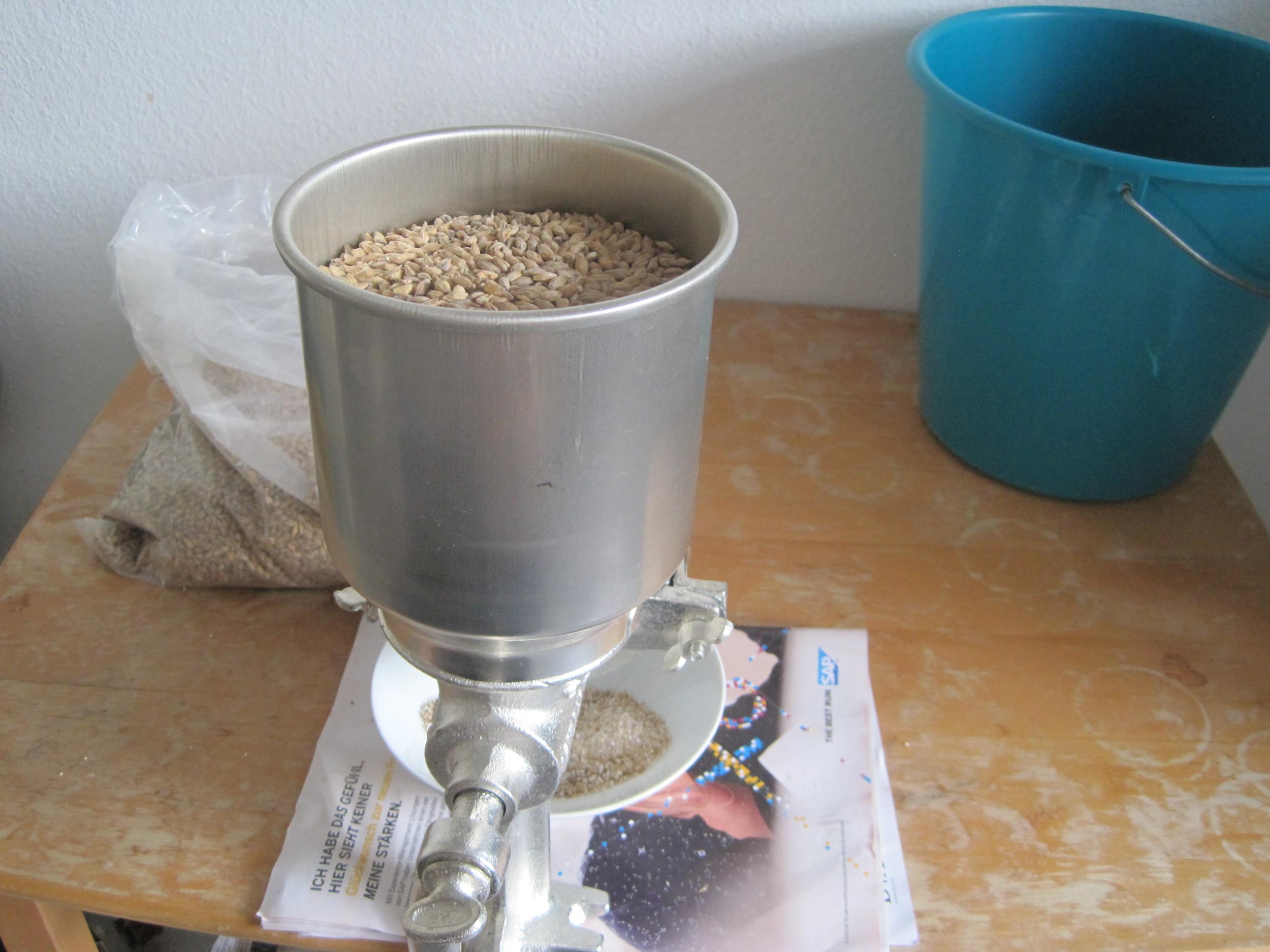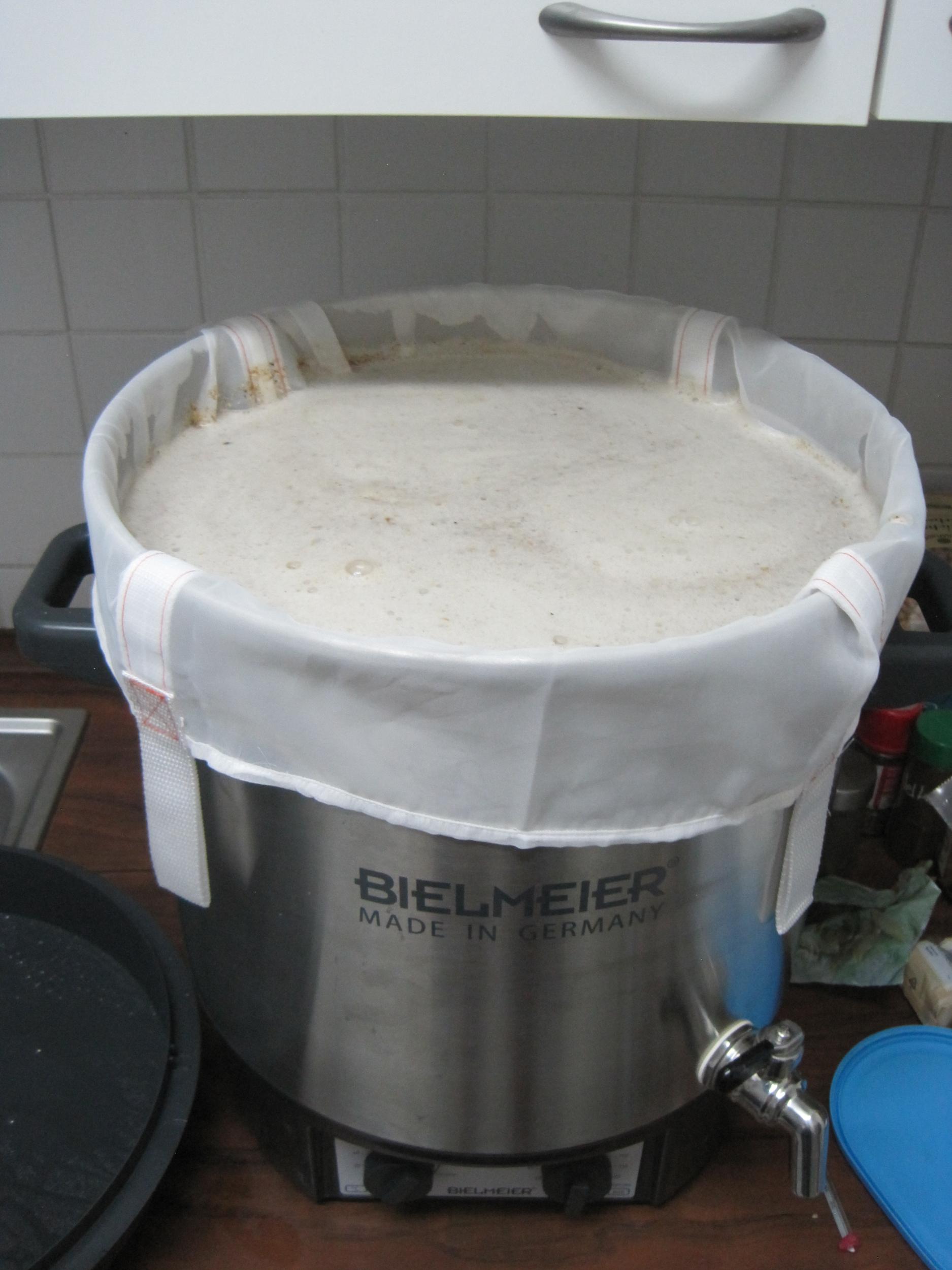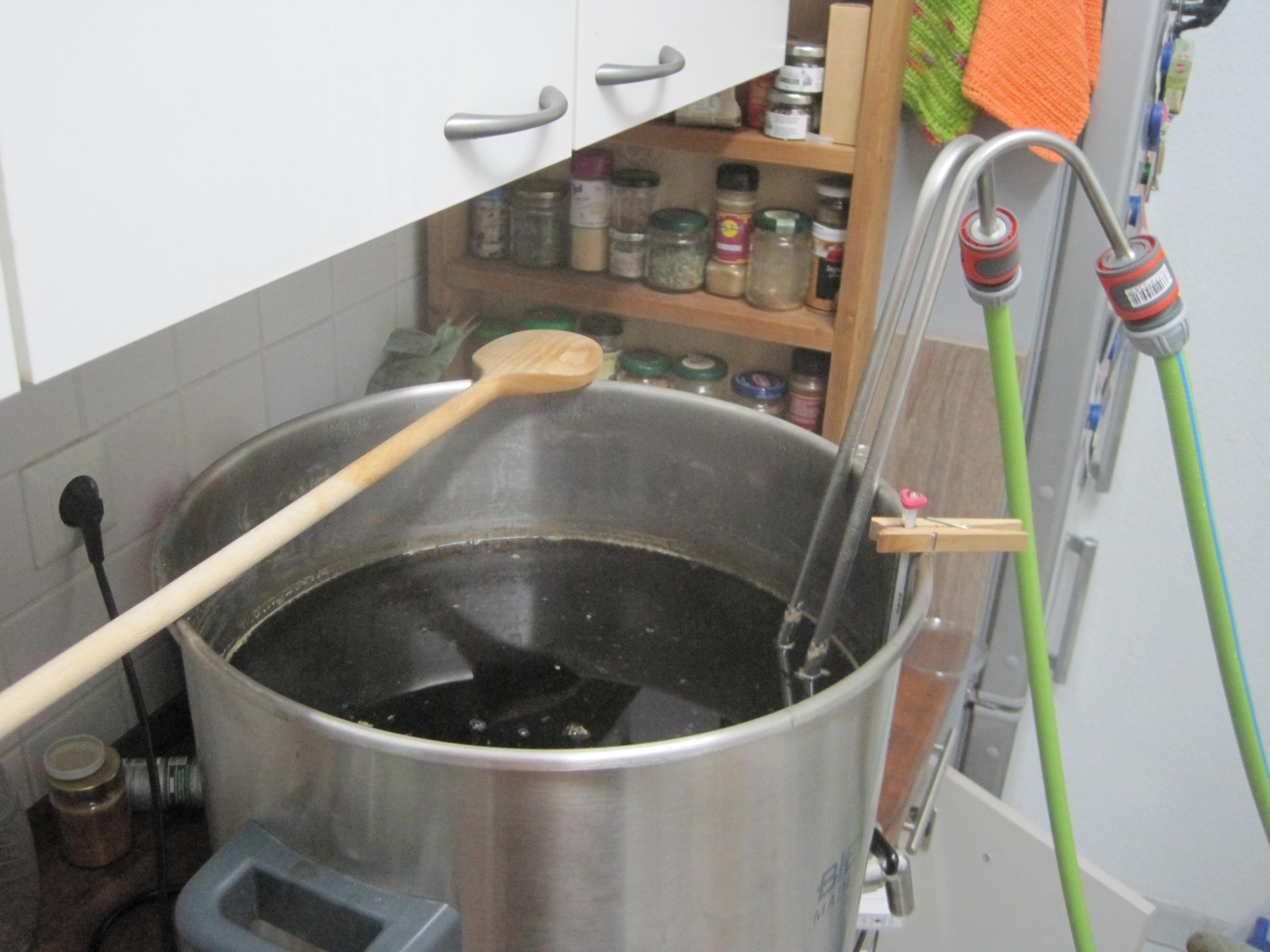Brudi-Bräu does not do tours like the big breweries do. For starters, most of the brewing equipment of Brudi-Bräu is non-stationary and stored in the basement if not used for brewing. Also a rooftop apartment's kitchen and storage compartment are not particularly exciting. Therefore, the master brewer shows you his 0.17 hectoliters brewing system in action in this virtual tour and explains how to make beer from hops, malt, water and yeast.

Making beer starts with the malt. Malt are grains on which the germination process was started artificially and stopped at a certain point. The reason for that is that the grains contain mostly starch and the production of beer requires sugars. The starch is converted to sugars in the germination process when the grain's enzymes are activated and break it down into simple sugar molecules. For that reason, the germination is started and stopped at a certain point. Depending on the malting process it results in either base malts or specialty malts. Base malts add mostly fermentable sugars and a little color and taste to the beer. Specialty malts have multiple purposes. They can make the beer sweeter (like caramel malts), give it a better head retention (like dextrin malt), add flavor (like melanoidin malt, smoked malt or acidulated malt) or color to the beer (like Carafa 2). In order to make beer, the malt must be crushed. Brudi-Bräu uses a simple, muscle-powered mill. It is important not to crush the malt too finely. Otherwise the husks are milled too and give the beer a grainy taste that most people consider an off-flavor.

After the malt is crushed, the mashing starts. Mashing is the process of extracting sugars from the malt. For this purpose, the malt is put into hot water for steeping. This is similar to making tea or a herbs infusion but with a giant tea bag, malt instead of herbs and a steeping time of 60-90 minutes. The temperature of the water is important to control the process. Between 65°C and 70°C the enzymes extract the sugar from the malt. The closer the temperatures get to 65°C, the more simple sugars are extracted by the alpha amylase. This leads to drier and and more pintable beers. The beta amylase works best close to 70°C and extracts more complex sugars that cannot be so easily fermented by the yeast. These more complex sugar molecules make the beer heavier and more full-bodied. It is obvious that the mash temperature is the first important parameter when making beer which has an important influence on the beer's taste. The duration of the mash is determined by the temperature. Cooler mashes take a while longer. Brudi-Bräu uses the Brew-in-a-bag technique for which a large bag is put into the brewing kettle. After the mash, the bag is pulled out of the mash and contains all the malt. The water, in which sugars and proteins are now solved is called mash and remains in the kettle for the boil. Thanks to the Brew-in-a-bag technique, all the steps take place in the same kettle which is advantageous for small kitchens. And it really sells the teabag analogy. The brewing malt can be baked into "Treberbrot", which you can imagine as a sweet and protein-rich kind of full-grain bread. One large batch of beer produces multiple kilograms of malt and we cannot eat that much Treberbrot. Therefore, we feed the rest to chickens.

The mash is then boiled for about 70 minutes. This denaturates proteins and dimethylsulfates that really should not be in beer. During the boil, the hops are added. Hops have three possible functions in beer. They have an antibacterial effect and prevent infections with Lactobacillus which would make the beer sour. Furthermore its bitterness helps balance the sweetness of the malt. And finally it adds flavor and aroma to the beer, which is especially important for hop-forward beers such as IPAs. Every hop variety has a specific flavor. The classic noble varieties such as Tettnanger, Saazer or Golding taste herbal or floral. Newer varietes for IPAs can taste of citrus (Cascade, Citra) or fruity (Hüll Melon, Callista). The effects of the hops on the beer depend on the time they are added to the boil. The earlier it is added, the more bitter it makes the beer. The later it is added, the more of its herbal, floral, citrusy or fruity characteristics make it into the beer. For easy removal after the boil, the hops can be put into a small bag which again resembles a tea bag. The boiled mash with its hop additions is called the wort.
During the boil, the yeast is prepared for fementation. It has the important role of turning sugar into alcohol and carbondioxide. In the top-fermenting Ales such as the ones that Brudi-Bräu produces, a yeast strain is used that is related to the yeast that we use for baking. It is however bred specifically for the requirements of alcohol production. They exist in dry and liquid form. Brudi-Bräu uses dry yeast. Theoretically these can just be sprinkled on top of the cooled wort. They suffer a temperature and sugar shock which kills half of the cells. It is better to rehydrate the dry yeast in warm (around 30°C) water and give them some time to turn liquid again. This process takes 30-45 minutes, depending on the yeast variety.

After the boil the wort must be cooled down as quickly as possible because if it is too warm for too long, the hops will add too much bitterness. Also a quick cooling to fermentation temperature reduces the risk of infections with Lactobacillus. A wort chiller is used for this. It is basically a spiral-shaped pipe made of stainless steel through which cold water is pumped. It is inserted into the hot wort which is cooled down to 25-30°C. During the cooling process, the trub and hop particles sink to the bottom of the kettle where they remain. When the wort reached pitching temperature for the yeast, the original gravity is measured. This value describes the density of the beer and later the alcohol content is calculated with it. After this measurement the tap of the kettle is opened and the beer splashes down into the fermenter from some height. This adds oxygen which the yeast needs in order to multiply. The yeast is added an the lid is put on the fermenter. An airlock is attached for the releasing of excess pressure. After that, the fermenter is placed in the storage cellar for two weeks for the primary fermentation of the beer.
In the storage cellar, the yeast transforms the sugar in the wort into alcohol. This process releases carbondioxide which is released through the airlock. The temperature of the fermentation is important for the taste of the beer. Higher temperatures result in faster fermentation with more side products such as esters and phenols. An example for that is the Weizenbier which tastes of banana and/or clove. Brudi-Bräu uses the natural fluctuation in the cellar to produce different beer styles. During the winter the cellar has a temperature of cool 15°C which are used for beers with a clear fermentation profiles such as Altbier, Baltic Porter and Scottish Heavy. In the spring and fall the cellars 20°C are used for more estery British and Belgian ales. The rather hot 25°C of the summer can only be used for the already mentioned Weizenbiers.

After two weeks (and sometimes more, depending on how quickly the yeast is working) the sugary wort has been transformed into a predecessor of beer. It has got most of the alcohol it will ever have but no carbonation yet and possibly some off-flavors that will disappear during the secondary fermentation in the bottle. Before the beer is carbonated its final gravity is measured. From the difference between the original and the final gravity the amount of sugar that was transformed into alcohol and with that the alcohol content of the beer can be calculated. After that a sugar solution is added to the beer. This creates the beer's carbonation during the secondary fermentation in the bottle. The fermentation produces carbondioxide which cannot leave the beer since the bottle is closed tight. The beer with the sugar solution is transferred into bottles and capped. The capped bottles are then stored in the basement for a couple of weeks. Depending on the style this storage time varies. Wheat beers for example finish after relatively short three weeks while Belgian Abbey Ales and Baltic Porters need several months. Brudi-Bräu does not terminate the secondary fermentation before shipping the bottles to customers. This means that you can let the beer mature for some time if you want but it is also very important that you place the bottles in your fridge for two days befor drinking it. This deactivates the yeasts in the beer.